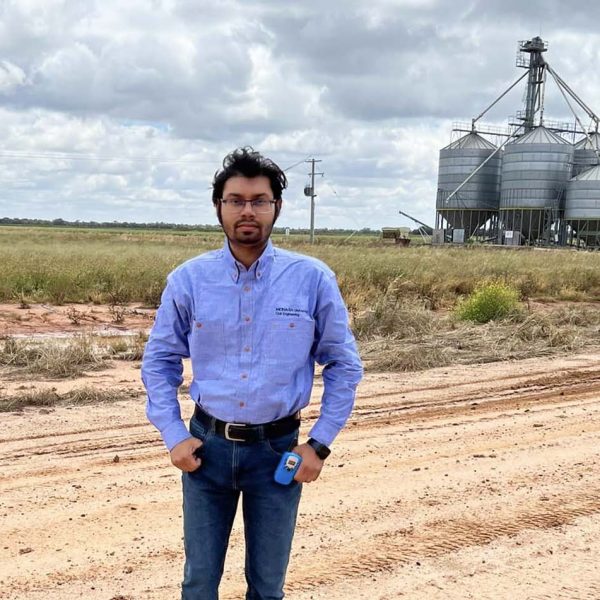PhD Student Profile

Dristi Datta
Charles Sturt University
Prediction of different soil auxiliary properties (e.g., soil moisture, carbon, nitrogen) is a significant field of study, as they are directly related to plant health and food production. Traditional methods for estimating these soil properties, such as oven-drying and chemical analysis, are both time and resource consuming, and can be used only for small land areas.
With the significant development of remote sensing, such as satellite sensors and multi/hyperspectral imaging technologies, different soil content can be predicted in a non-invasive and cost-effective way for large areas of bare soil. However, farmers and other stakeholders may need to predict soil content for vegetation-covered soil areas to take immediate actions, e.g., applying fertilisers or yield estimations in the crop growing time.
This project aims to develop a decision support system using remote sensing imaging of the vegetation canopy for quantifying different soil properties by considering the vegetation health patterns which are mainly influenced by the auxiliary soil properties.
First, we evaluate the performance of different learning-based models to predict a number of auxiliary soil properties using lab-based hyperspectral data, which can be the highest possible achievable performance using hyperspectral technology. Then we will use satellite data to explore the possibilities of predicting soil properties from the mixed (i.e., bare and vegetation-covered) soil for the vast areas to investigate whether predictions from satellite images are as accurate as those from lab-based hyperspectral datasets.
Finally, we aim to develop a decision support system to predict soil properties in the vegetation-covered area by establishing the relationship between vegetation health patterns and soil contents.
PhD Title: “Developing an Imagery-Based Decision Support System for Soil Assessment Using Remote Sensing”
PhD start date: January 2022
Supervisors: Dr. Manoranjan Paul (Charles Sturt University), Dr. Manzur Murshed (Deakin University), Dr. Shyh Wei Teng (Federation University) and Dr. Leigh M. Schmidtke (Charles Sturt University)
What interested you about this sort of research?
The interdisciplinary nature of this research captured my interest from the outset. Combining principles from remote sensing, machine learning, and soil science enables me to explore novel approaches for soil assessment that bridge the gap between traditional laboratory methods and large-scale field applications. The prospect of developing practical tools that address the needs of agricultural stakeholders motivates me to push the boundaries of current knowledge in this field.
What do you love about soil?
Soil, to me, represents the foundation of life. Its complexity and diversity fascinate me, as it serves as the medium through which plants grow and ecosystems thrive. I admire how soil embodies a delicate balance of physical, chemical, and biological processes, and I am driven to understand and protect this essential resource for future generations.
What do you love about your PhD?
What excites me about my PhD is the opportunity to harness cutting-edge technologies like remote sensing and learning-based techniques to tackle real-world challenges in agriculture. I am passionate about developing innovative solutions that have the potential to revolutionise how we assess and manage soil health, ultimately contributing to global food security and environmental sustainability.
How will your PhD help to make a difference for farmers or other end or next users?
My PhD research aims to provide farmers and stakeholders with a powerful decision support system that utilises remote sensing imagery to accurately predict soil properties in both bare and vegetation-covered areas. By offering non-invasive and cost-effective soil assessment tools, my work can empower agricultural practitioners to make informed decisions about crop management practices, such as fertiliser application and yield estimations, leading to improved productivity and sustainable land use.
What do you want to do when you finish your PhD?
I aspire to continue working at the intersection of agriculture, technology, and environmental conservation. Whether in academia, industry, or government, I aim to apply my expertise to develop practical solutions that address pressing challenges in sustainable agriculture and land management, contributing to global efforts towards a more resilient and food-secure future.
My publications
- Datta, D., Paul, M., Murshed, M., Teng, S. W., & Schmidtke, L. (2022). Soil Moisture, Organic Carbon, and Nitrogen Content Prediction with Hyperspectral Data Using Regression Models. Sensors, 22(20), 7998.
- Datta, D., Paul, M., Murshed, M., Teng, S. W., & Schmidtke, L. (2023). Comparative Analysis of Machine and Deep Learning Models for Soil Properties Prediction from Hyperspectral Visual Band. Environments, 10(5), 77.
- Datta, D., Paul, M., Murshed, M., Teng, S. W., & Schmidtke, L. M. (2023, November). Novel Dry Soil and Vegetation Indices to Predict Soil Contents from Landsat 8 Satellite Data. In 2023 International Conference on Digital Image Computing: Techniques and Applications (DICTA) (pp. 152-159). IEEE.
- Datta, D., Paul, M., Murshed, M., Teng, S. W., & Schmidtke, L. (2024). Unveiling Soil-Vegetation Interaction: Reflection Relationships and an Attention-Based Deep Learning Approach for Carbon Prediction. (Accepted to ICME)
Find out more
- Related article: Harnessing technology to solve complex problems
Connect with Dristi online
